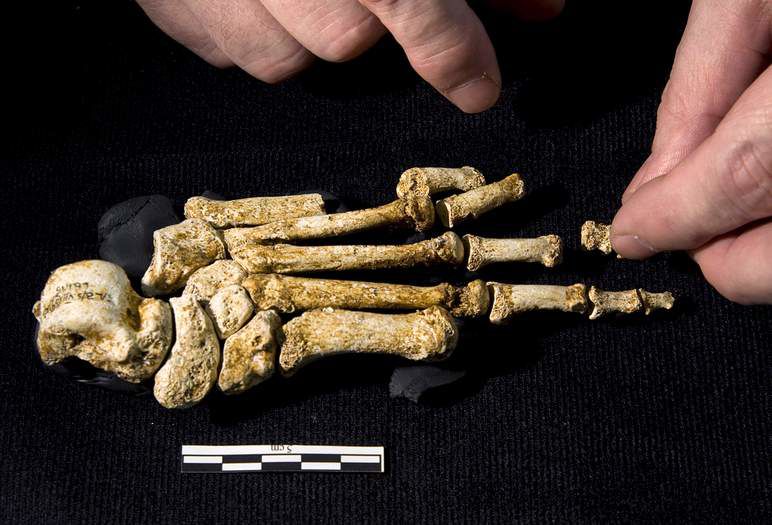Long feet offer clues to mystery of ‘hobbits’
Published 5:00 am Friday, May 29, 2009

- “Hobbit” foot bones found on the island of Flores in Indonesia bolster the claim that hobbits belonged to a primitive group distinct from modern humans.
The extinct hominids commonly known as “hobbits” may have been small of body and brain, but their feet were exceptionally long, and they were flat.
Scientists, completing the first detailed analysis of the hominid’s foot bones, say the findings bolster their controversial interpretation that these individuals belonged to a primitive population distinct from modern humans that lived as recently as 17,000 years ago on the Indonesian island of Flores.
The new anatomical evidence, being reported earlier this month in the journal Nature, is unlikely to solve the mystery of just where the species — formally designated Homo floresiensis — fits in human evolution. That fact even the researchers acknowledge, and some of their critics still contend that the skull and bones are nothing more than remains of modern pygmy humans deformed by genetic or pathological disorders.
The controversy erupted almost immediately after the H. floresiensis discovery was announced in 2004. The single skull was unusually small, indicating its brain was no bigger than a chimpanzee’s. It topped a body little more than 3 feet tall.
The research
Now, the examination of lower limbs and especially an almost complete left foot and parts of the right, the researchers reported, shows that the species walked upright, like other known hominids. There were five toes, as in other primates, but the big toe was stubby, more like a chimp’s.
Stranger still was the size of the feet — more than 71⁄2 inches long, out of proportion to its short lower limbs. The imbalance evoked the physiology of some African apes, but it has never before been seen in hominids.
And then there were those flat feet. Humans sometimes have fallen arches and flat feet, but scientists noted that this was no human foot. The navicular bone, which helps form the arch in the modern foot, was especially primitive, more akin to one in great apes. Without a strong arch, the hominid would have lacked the springlike action needed for efficient running. It could walk, but not run like humans.
Weighing the new evidence, the re- search team, led by William Jungers, a paleoanthropologist at the Stony Brook Medical Center on Long Island, concluded that “the foot of H. floresiensis exhibits a broad array of primitive features that are not seen in modern humans of any body size.”
The team contended that it is improbable that all of these traits from head to toe — including small brain and primitive shoulders and wrists, as previously reported — “were simply a consequence of ‘island dwarfing.’”
Jungers and his colleagues raised the possibility that the ancestor of the species was not Homo erectus, as had been assumed. H. erectus is known as the earliest hominid to leave Africa and make its way across Asia. At a symposium two weeks ago, several scientists edged toward the view that the so-called hobbits emerged from another, more primitive hominid ancestor.
Some converts …
In a commentary accompanying the journal report, Daniel Lieberman, a paleoanthropologist at Harvard University who was not a member of the team, noted that the initial skepticism over the hominid as a distinct species was understandable.
“All in all, many scientists (myself included) have sat on the fence, waiting for more evidence about the nature and form of H. floresiensis,” Lieberman wrote. “And now we have some.”
Lieberman, who specializes in hominid locomotion studies, said the primitive foot provided a “tantalizing model” for a non-modern hominid that “evolved for effective walking before selection for endurance running occurred in human evolution.”
That might have occurred even before H. erectus, judging by footprints in Africa of an erectus with an apparently humanlike foot. Some scientists speculate that the ancestor of H. floresiensis evolved from an earlier and smaller erectus, or the enigmatic Homo habilis, or even a pre-Homo genus.
… and a competing theory
In a related report in the journal, Eleanor Weston and other researchers at the Natural History Museum in London suggested that the H. floresiensis skull might be that of an erectus that had become dwarfed from living isolated on an island. They made the proposal based on a study of extinct dwarf hippos on Madagascar, whose brains were 30 percent smaller than would be expected by scaling down their mainland African ancestor.
William Harcourt-Smith, a paleoanthropologist at the American Museum of Natural History and co-author of the Nature paper, said in an interview, “We have been very careful to consider variables within a species and possible pathologies, but this hobbit foot is another strong piece of evidence that they were nothing like us.”






